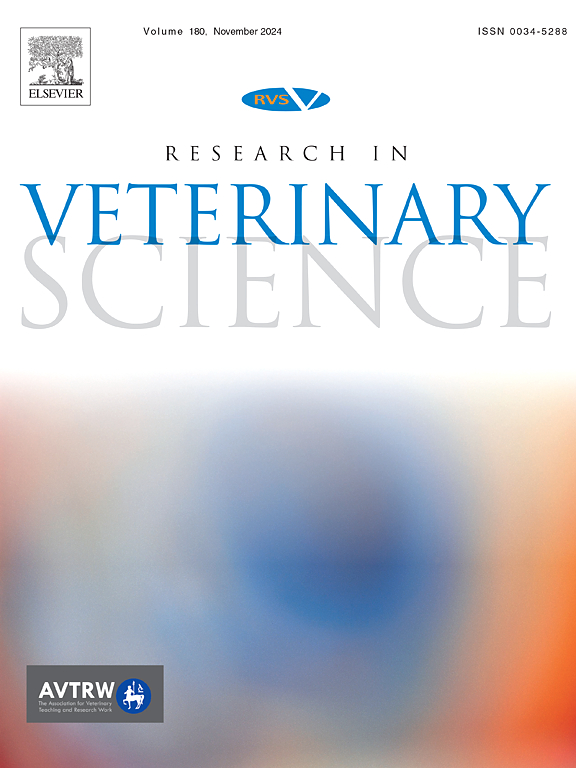猫和小型犬股骨和髋骨近端骨小梁和皮质结构的微电脑断层分析。
IF 2.2
3区 农林科学
Q1 VETERINARY SCIENCES
引用次数: 0
摘要
本研究旨在提供一个初步的数据库,以获得更详细的猫和小型犬骨盆和股骨骨的骨小梁和皮质骨结构的知识。此外,还比较了猫和较小的狗之间的骨骼微结构,以确定这些物种之间可能存在的差异。这些发现可能会促进非骨水泥全髋关节置换术(THR)的发展。为了确定骨微结构,我们使用微计算机断层扫描分析了小型犬(21只)和猫(27只)的48个骨盆和96个髋臼和股骨。测定骨体积(BV/TV)、骨表面积(BS/BV)、骨小梁厚度(Tb.Th)、骨小梁数目(Tb.N)、骨小梁间距(Tb.Sp)、骨各向异性程度(DA)、骨连通性密度(Conn. D)和平均骨密度,并进行比较。此外,测定股骨两侧的前扭角。总的来说,猫在骨盆和股骨的分析区域比小型犬有更少但更厚的小梁。这导致猫的小梁距离比小狗大。结合猫股骨干处较高的皮质骨密度,可以确定猫在测量区域的骨结构比较小的狗更稳定。猫和狗的前扭力角度没有显著差异。本文章由计算机程序翻译,如有差异,请以英文原文为准。
Microcomputed tomographic analysis of the trabecular and cortical architecture of the proximal femur and hip bone of cats and small breed dogs
This study aims to provide an initial database to gain more detailed knowledge of the trabecular and cortical bone structure of pelvic and femur bones in cats and smaller dogs. Additionally, the bony microarchitecture between cats and smaller dogs was compared to identify possible differences between those species. These findings could potentially improve the development of non-cemented total hip replacement (THR). To determine the bony microarchitecture, a total of 48 pelvises and thus 96 acetabuli and femora of smaller dogs (n = 21) and cats (n = 27) were analysed using microcomputed tomography. The parameters bone volume (BV/TV), bone surface (BS/BV), trabecular thickness (Tb.Th), number of trabeculae (Tb.N), trabecular spacing (Tb.Sp), degree of anisotropy (DA), connectivity density (Conn. D) and mean bone density were measured and compared between the species. In addition, the femoral angle of antetorsion was determined on both sides of the body.
Overall, cats had fewer but thicker trabeculae than the small dogs in the analysed areas of the pelvis and femur. This resulted in a greater trabecular distance in cats than in small dogs. Together with a higher cortical bone density at the femoral shaft in cats, it could be determined that cats have a more stable bone architecture in the measured areas than smaller dogs. The angle of antetorsion did not differ significantly between the cats and the dogs examined.
求助全文
通过发布文献求助,成功后即可免费获取论文全文。
去求助
来源期刊

Research in veterinary science
农林科学-兽医学
CiteScore
4.40
自引率
4.20%
发文量
312
审稿时长
75 days
期刊介绍:
Research in Veterinary Science is an International multi-disciplinary journal publishing original articles, reviews and short communications of a high scientific and ethical standard in all aspects of veterinary and biomedical research.
The primary aim of the journal is to inform veterinary and biomedical scientists of significant advances in veterinary and related research through prompt publication and dissemination. Secondly, the journal aims to provide a general multi-disciplinary forum for discussion and debate of news and issues concerning veterinary science. Thirdly, to promote the dissemination of knowledge to a broader range of professions, globally.
High quality papers on all species of animals are considered, particularly those considered to be of high scientific importance and originality, and with interdisciplinary interest. The journal encourages papers providing results that have clear implications for understanding disease pathogenesis and for the development of control measures or treatments, as well as those dealing with a comparative biomedical approach, which represents a substantial improvement to animal and human health.
Studies without a robust scientific hypothesis or that are preliminary, or of weak originality, as well as negative results, are not appropriate for the journal. Furthermore, observational approaches, case studies or field reports lacking an advancement in general knowledge do not fall within the scope of the journal.
 求助内容:
求助内容: 应助结果提醒方式:
应助结果提醒方式:


